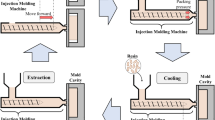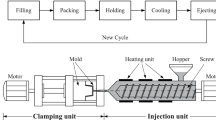Abstract
A sequential optimization design method based on artificial neural network (ANN) surrogate model with parametric sampling evaluation (PSE) strategy is proposed in this paper. The quality index, such as warpage deformations, thickness uniformity, and so on, is a nonlinear, implicit function of the process conditions, which are typically evaluated by the solution of finite element (FE) equations, a complicated task which often involves huge computational effort. The ANN model can build an approximate function relationship between the design variables and quality index, replacing the expensive FE reanalysis of the quality index in the optimization. Moldflow Corporation’s Plastics Insight software is used to analyze the quality index of the injection-molded parts. The optimization process is performed by a Parametric Sampling Evaluation (PSE) function. PSE is an infilling sampling criterion. Although the design of experiment size is small, this criterion can take the relatively unexpected space into consideration to improve the accuracy of the ANN model and quickly tend to the global optimization solution in the design space. As examples, a scanner, a TV cover, and a plastic lens are investigated. The results show that the sequential optimization method based on PSE sampling criterion can converge faster and effectively approach to the global optimization solution.
Similar content being viewed by others
References
Yen C, Lin JC, Li W, Huang MF (2006) An abductive neural network approach to the design of runner dimensions for the minimization of warpage in injection mouldings. J Mater Process Technol 178(1–3):1–8
Yuanxian GU, Haimei LI, Changyo S (2001) Numerical simulation of thermally induced stress and warpage in injection-molded thermoplastics. Adv Polym Technol 20(1):14–21
Huang MC, Tai CC (2001) The effective factors in the warpage problem of an injection-molded part with a thin shell feature. J Mater Process Technol 110(1):1–9
Wang TH, Young WB, Wang J (2002) Process design for reducing the warpage in thin-walled injection molding. Int Polym Process 17(2):146–152
Fan B, Kazmer DO, Bushko WC, Theriault RP, Poslinski A (2003) Warpage prediction of optical media. J Polym Sci Part B: Polym Phys 41(9):859–872
Liao SJ, Chang DY, Chen HJ, Tsou LS, Ho JR, Yau HT, Hsieh WH, Wang JT, Su YC (2004) Optimal process conditions of shrinkage and warpage of thin-wall parts. Polym Eng Sci 44(5):917–928
Dong BB, Shen CY, Liu CT (2005) The effect of injection process parameters on the shrinkage and warpage of PC/ABS’s part. Polym Mater Sci Eng 21(4):232–235
Kurtaran H, Erzurumlu T (2006) Efficient warpage optimization of thin shell plastic parts using response surface methodology and genetic algorithm. Int Adv Manuf Technol 27(5–6):468–472
Ozcelik B, Erzurumlu T (2006) Comparison of the warpage optimization in the plastic injection molding using ANOVA, neural network model and genetic algorithm. J Mater Process Technol 171(3):437–445
Chiang KT, Chang FP (2007) Analysis of shrinkage and warpage in an injection-molded part with a thin shell feature using the response surface methodology. Int Adv Manuf Technol 35(5–6):468–479
Gao YH, Turng LS, Wang XC (2008) Adaptive geometry and process optimization for injection molding using the Kriging surrogate model trained by numerical simulation. Adv Polym Technol 26(5):1–16
Lee BH, Kim BH (1995) Optimization of part wall thicknesses to reduce warpage of injection-molded parts based on the modified complex method. Polym Plast Technol Eng 34(5):793–811
Sahu R, Yao DG, Kim B (1997) Optimal mold design methodology to minimize warpage in injection molded parts. Technical papers of the 55th SPE ANTEC Annual Technical Conference, Toronto, Canada, April/May 1997, vol 3, pp 3308–3312
Tang SH, Tan YJ, Sapuan SM, Sulaiman S, Ismail N, Samin R (2007) The use of Taguchi method in the design of plastic injection mould for reducing warpage. J Mater Process Technol 182(1–3):418–426
Oktem H, Erzurumlu T, Uzman I (2007) Application of Taguchi optimization technique in determining plastic injection molding process parameters for a thin-shell part. Mater Des 28(4):1271–1278
Gao YH, Wang XC (2009) Surrogate-based process optimization for reducing warpage in injection molding. J Mater Process Technol 209(3):1302–1309
Jones DR, Schonlau M, Welch WJ (1998) Efficient global optimization of expensive black-box functions. J Glob Opti 13(4):455–492
Kurtaran H, Ozcelik B, Erzurumlu T (2005) Warpage optimization of a bus ceiling lamp base using neural network model and genetic algorithm. J Mater Process Technol 169(10):314–319
Shi HZ, Gao YH, Wang XC (2010) Optimization of injection molding process parameters using integrated artificial neural network and expected improvement function method. Int J Adv Manuf Technol 48(9–12):955–962
Ozcelik B, Erzurumlu T (2005) Determination of effecting dimensional parameters on warpage of thin shell plastic parts using integrated response surface method and genetic algorithm. Int Commun Heat Mass Transfer 32(8):1085–1094
Zhou J, Turng LS, Kramschuster A (2006) Single and multiobjective optimization for injection molding using numerical simulation with surrogate models and genetic algorithms. Int Polym Process 21(5):509–520
Woll SLB, Cooper DJ (1997) Pattern-based closed-loop quality control for the injection molding process. Polym Eng Sci 37(5):801–812
Sadeghi BHM (2000) A BP-neural network predictor model for plastic injection molding process. J Mater Process Technol 103(3):411–416
Chow TT, Zhang GQ, Lin Z, Song CL (2002) Global optimization of absorption chiller system by genetic algorithm and neural network. Energy Build 34(1):103–109
Cook DF, Ragsdale CT, Major RL (2000) Combining a neural network with a genetic algorithm for process parameter optimization. Eng Appl Artif Intell 13(4):391–396
Shen CY, Wang LX, Li X (2007) Optimization of injection molding process parameters using combination of artificial neural network and genetic algorithm method. J Mater Process Technol 183(2–3):412–418
Shen CY, Wang LX, Zhang QX (2005) Process optimization of injection molding by the combining ANN/HGA method. Polym Mater Sci Eng 21(5):23–27
Cheng J, Li QS (2009) A hybrid artificial neural network method with uniform design for structural optimization. Comput Mech 44(1):61–71
Author information
Authors and Affiliations
Corresponding author
Appendix 1
Appendix 1
Definition 1
If p is a positive real variable, and E = {e j (I), j = 1, 2,…, m} is a set of sampling evaluation functions, then
is a parametric sampling evaluation function, where p is a positive real variable and the sampling evaluation function at sampling point j is
Definition 2
If, for any \( E(I) = \left\{ {{e_1}(I),{e_2}(I), \cdot \cdot \cdot, {e_m}(I)} \right\} \), and \( \overline E (I) = \left\{ {{{\overline e }_1}(I),{{\overline e }_2}(I), \cdots, {{\overline e }_m}(I)} \right\} \), \( E(I),\overline E (I) \in {E^m} \) with \( {e_j}(I) \leqslant {\overline e_j}(I) \) (1 ≤ j ≤ m) and there exists at least one \( {{{j {_0}}}}(1 \leqslant{{j_0} } \leqslant m) \) such that \( {e_{j_{0}}} (I) < {\overline e_{j_{0}}}(I)\), then \( E(I) \leqslant \overline E (I)\) or simply \( E \leqslant \overline E\).
Definition 3
If, for any \( E,\overline E \in {E^m} \) with \( E \leqslant \overline E \), \( S(E) < S(\overline E ) \), then S(E) is a strictly monotone increasing function of E.
Theorem 1
The PSE function S(E) is a strictly monotone increasing function of E, and if p → ∞ then
Proof. Let
by Definition 2
and there exists at least one j 0(1 ≤ j 0 ≤ m) such that
Then for p > 0,
Hence
Taking logarithms on both sides and dividing by p
i.e., S(E) is a strictly monotone increasing function of increasing function of E.
The p norm of the q-dimensional vector
is given by
The uniform norm, also called the maximum norm, is defined by
Since \( {{e}^{{{{e}_{j}}(I)}}} > 0 \) by Jensen’s inequality, the norm is a strictly monotone decreasing function of its order, i.e.
The importance of this inequality is that it holds also in the limit as p → ∞. Thus, we have
Taking logarithms on both side of equation gives
and the proof is completed.
Rights and permissions
About this article
Cite this article
Shi, H., **e, S. & Wang, X. A warpage optimization method for injection molding using artificial neural network with parametric sampling evaluation strategy. Int J Adv Manuf Technol 65, 343–353 (2013). https://doi.org/10.1007/s00170-012-4173-5
Received:
Accepted:
Published:
Issue Date:
DOI: https://doi.org/10.1007/s00170-012-4173-5




